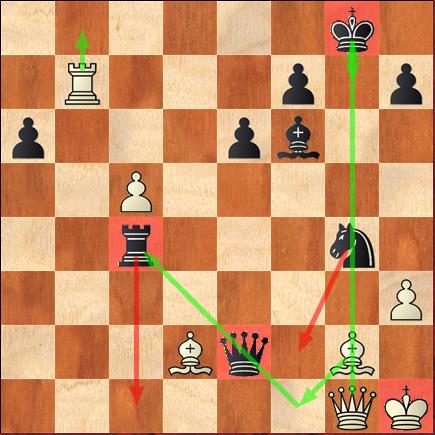Tactics play a vital role in the game of chess. Tactics is everything in chess. Chess, as you all know, is a fair game with no room for chance or luck whatsoever to either of the players. The players ultimately decide the fate of their result in the game. A slight lapse of concentration, a slight miscalculation or a little oversight is just sufficient to allow your opponent to say checkmate to you.
Tactics might just involve distracting the opponent’s pieces, sacrificing pieces to achieve a broader goal, mating threats, checks, and all such other things.
Let me explain the role of tactics by way of an example where a literally losing position for the black pieces has not only been avoided, but the black went on to win the game in the next 3-4 moves.
This is the position after 38 moves, and white has to move next:
White to Move

Black to Move
A closer look at the position shows that White is in a stronger position with more possibilities for winning.
The Black king at g8 is vulnerable, in that if White rook at b7 gives a check from b8, then black king has no option but to move to g7. One tactic here for white might be to arrest the movement of Black King to g7, which would then result in a checkmate. White’s bishop at d2 can be moved to h6 for this purpose.
It is essential that a chess player visualizes at least 2-3 moves in advance and plans his moves taking into consideration all other possible alternatives, such that his goal or tactics succeeds.
Before jumping into the move straightaway, let us see what would be the possible response from black for this move. Black, visualizing the threat of mate if no action is taken, might have no other alternative but to capture the white bishop at h6 using the Knight at g4. What will happen if Black Knight at g4 takes the bishop at h6?
One may also notice that the Black queen at e2 and black rook at c4 are in a single diagonal. White might think of moving the bishop at g2 to f1, which will result in a discovered check by Queen. At the same time, the Black Queen can be captured at ease by White bishop making it simpler for White to say checkmate.
The vulnerability of Black’s position and the advantages or possible moves for White, which is to move now, is depicted in the following diagram.

So, the White, considering all possible options, has taken the right decision of moving the bishop at d2 to h6, harassing the Black King at g2. Now the position would be as follows :

Black is facing a potential checkmate now as the next move by White, moving the rook at b7 to b8 will be a checkmate.
Let us look at the position closely from the black’s point of view. What are the possible options available to Black to thwart the White’s move. One thing is he can consider moving the black bishop at f6 to e5 to thwart the White rook’s move to b8. White may then move the bishop at g2 to f1as the black queen and black rook are in a single diagonal. This move by white’s bishop will also block the Black knight at g4.
What might be the other possibility for Black now?

The white King at h1 is also not very safe. It is equally vulnerable as is the Black king in g8. One possible option for Black might be to threaten the White king with a check. The Black knight at g4 is at a good position to threaten with a check by moving to f2. The response from White for that check from Black knight would be either to move the King to h2 or capture the Knight at f2 by Queen.
If the King is moved to h2, then Black can move the bishop at f6 to e5 and the check would be the final nail in the coffin for white, leading to checkmate. If the White queen captures the black knight at f2, then Black rook at c4 can be moved to c1 for giving check at White king. Now white has no other option but to use his bishop at h6 to capture the black rook at c1. By this move, Black has successfully thwarted the threat of mate from White and also is in a great position to capture the White queen placed at f2. This will be a great opportunity for black to win.
The game concluded as follows :
39. Bh6 Nf2+
40. Qxf2 Rc1+
And, White resigned the game conceding the defeat. This is what tactics is all about.


Trackbacks/Pingbacks